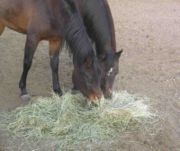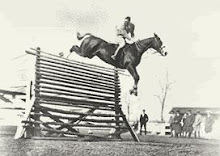Feeding
A horse or pony needs approximately 1.5% to 2.5% of its body weight in food per day. This may include forages such as grass or hay, and concentrates such as grain or commercially prepared pelleted feeds. Like people, some horses are "easy keepers" and prone to obesity, while others are "hard keepers" and need a great deal of food just to maintain a slim build. The average riding horse weighs roughly 1000 pounds, but the weight of a horse can be more closely estimated using a weight tape, which can be purchased from a feed store or tack shop.
Best practice is to feed horses two or three times daily, unless they are on full time pasture. Fresh, clean water should be provided free choice at all times, unless there is a specific reason to limit water intake for a short period of time.
A horse that is not ridden daily or subjected to other stressors can maintain adequate nutrition on pasture or hay alone, with adequate water (10-12 gallons per day minimum) and free access to a salt block or loose salt. However, horses and ponies in regular work often need a ration of both forage and concentrates.
Horses that are fed improperly may develop colic or laminitis, particularly if fed spoiled feed, subjected to excessive feed, or a too-abrupt change of feed. Young horses who are improperly fed may develop growth disorders due to an imbalance of nutrients.
Grooming
Horses groomed regularly have healthier and more attractive coats. Many horse management handbooks recommend grooming a horse daily, though for the average modern horse owner, this is not always possible. However, a horse should always be groomed before being ridden to avoid chafing and rubbing of dirt and other material, which can cause sores on the animal and also grind dirt into horse tack. Grooming also allows the horse handler to check for injuries and is a good way to gain the trust of the animal.
Proper basic grooming of a horse is a multi-step process involving several simple tools:
- Curry: Usually a round tool with short teeth made of plastic or stiff rubber, used to loosen dirt, hair, and other detritus, plus stimulate the skin to produce natural oils.
- Dandy brush: A stiff-bristled, "dandy" brush is used to remove the dirt, hair and other material stirred up by the curry. The best quality dandy brushes are made of stiff natural bristles such as rice stems, plastic-bristled dandy brushes are more common.
- Body brush: A soft-bristled "body" brush removes finer particles and dust. Some natural body brushes are made of boar bristles, like human hairbrushes, others are made of soft synthetic fibers.
- Grooming rag or towel: A terrycloth towel or other type of cloth. Sometimes called a "stable rubber."
- Mane brush or comb: Horses with short, pulled manes have their manes combed with a wide-toothed plastic or metal comb. Horse tails and long manes are brushed with either a dandy brush or a suitable human hairbrush.
- Hoof pick: All four feet of the horse need to be cleaned out. See "Hoof care and shoeing," below.
- In special weather conditions, a metal shedding blade with short, dull teeth is used to remove loose winter hair. Metal grooming tools used on sheep and show cattle may also be too harsh to use on a horse.
- In the summer, fly spray is often applied to the horse after grooming.
- Sweat or Water Scraper: A metal or plastic tool to remove excess liquid from a horse's coat.
- Sometimes, though not always, horses are clipped with scissors or, preferably, electric clippers. The most common areas are a short "bridle path" just behind the ears, where a few inches of mane is removed to help the bridle lay more neatly; and the fetlocks, where extra hair can collect undesired amounts of mud and dirt. For horse show and exhibition purposes, additional clipping may be done.
Beyond the basic equipment, there are literally thousands of grooming tools on the market, from multiple designs on the basic brushes, available in many colors, to specialized tools for braiding manes, polishing hooves and clipping loose hair. There are also grooming products for horses ranging from moisturizing hair dressings to glitter gel and hoof polish.
Horses can be bathed by being wet down with a garden hose, but they do not require bathing and many horses live their entire lives without a bath. Either horse or human shampoo may be safely used on a horse, if thoroughly rinsed out, and cream rinses or hair conditioners, similar to those used by humans, are often used on show horses. Too-frequent shampooing can strip the hair coat of natural oils and cause it to dry out. A well-groomed, clean horse can be kept clean by wearing a horse blanket or horse sheet.
A horse show class that considers quality of grooming for as much as 40% of the total score is called showmanship.
Hoof care and shoeing

The hooves of a horse or pony are cleaned by being picked out with a hoof pick to remove any stones, mud and dirt and to check that the shoes (if worn) are in good condition. Keeping feet clean and dry wherever possible helps prevent both lameness as well as hoof diseases such as thrush (a hoof fungus). The feet should be cleaned every time the horse is ridden, and if the horse is not ridden, it is still best practice to check and clean feet frequently. Daily cleaning is recommended in many management books, but in practical terms, a weekly hoof check of healthy horses at rest is often sufficient during good weather.
Use of hoof oils, dressings, or other topical treatments varies by region, climate, and the needs of the individual horse. Many horses have healthy feet their entire lives without need for any type of hoof dressing. While some horses may have circumstances where a topical hoof treatment is of benefit, improper use of dressings can also create hoof problems, or make a situation worse instead of better. Thus, there is no universal set of guidelines suitable for all horses in all parts of the world. Farriers and veterinarians in a horse owner's local area can provide advice on the use and misuse of topical hoof dressings, offering suggestions tailored for the needs of the individual horse.
Horses and ponies require routine hoof care by a professional farrier every 6 to 8 weeks, depending on the animal, the work it performs and, in some areas, weather conditions. Hooves usually grow faster in the spring and fall than in summer or winter. They also appear to grow faster in warm, moist weather than in cold or dry weather. In damp climates, the hooves tend to spread out more and wear down less than in dry climates, though more lush, growing forage may also be a factor. Thus, a horse kept in a climate such as that of Ireland may need to have its feet trimmed more frequently than a horse kept in a drier climate such as Arizona, in the southwestern United States.
All domesticated horses need regular hoof trims, regardless of use. Horses in the wild do not need hoof trims because they travel as much as 50 miles (80 km) a day in dry or semi-arid grassland in search of forage, a process that wears their feet naturally. Domestic horses in light use are not subjected to such severe living conditions and hence their feet grow faster than they can be worn down. Without regular trimming, their feet can get too long, eventually splitting, chipping and cracking, which can lead to lameness.
On the other hand, horses subjected to hard work may need horseshoes for additional protection. Some advocates of the barefoot horse movement maintain that proper management may reduce or eliminate the need for shoes, but certain activities, such as horse racing and police horse work, create unnatural levels of stress and will wear down hooves faster than they would in nature. Thus, some types of working horses almost always require some form of hoof protection.
The cost of farrier work varies widely, depending on the part of the world, the type of horse to be trimmed or shod, and any special issues with the horse's foot that may require more complex care. The cost of a trim is roughly half to one-third that of the cost of a set of shoes, and professional farriers are typically paid at a level commeasurate with other skilled labourers in an area, such as plumbers or electricians, though farriers charge by the horse rather than by the hour.
In the United Kingdom, It is illegal for anyone else other than a registered farrier to shoe or trim a horse's feet. The farrier should have any one of the following qualifications, the FWCF being the most highly skilled:
- DipWCF (Diploma of the Worshipful Company of Farriers)
- AWCF (Associateship of the Worshipful Company of Farriers)
- FWCF (Fellowship of the Worshipful Company of Farriers)
In the USA, there are no legal restrictions on who may do farrier work. However, trained and qualified farriers usually belong to professional organizations such as: the AFA (American Farrier's Association), which certifies farriers as Intern, Journeyman, and Certified Farrier.





